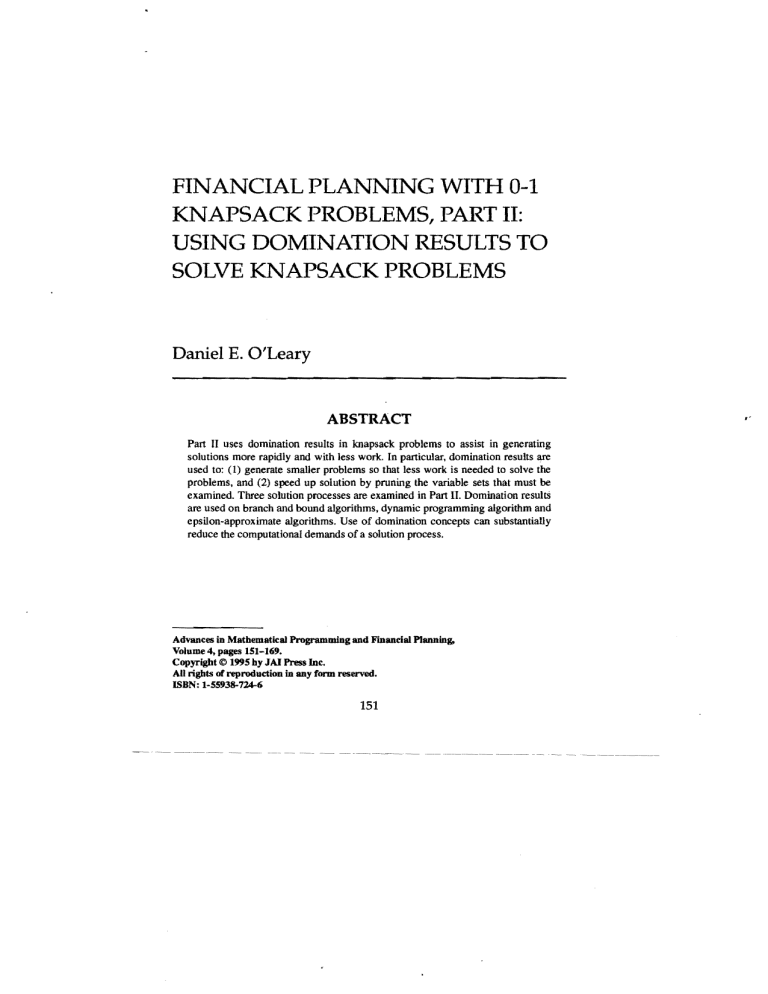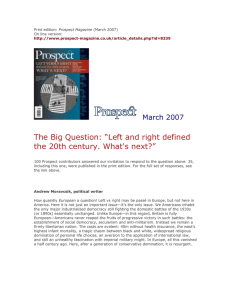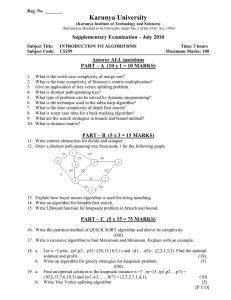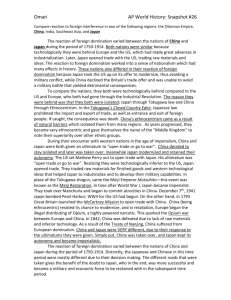Knapsack Problems: Domination Results & Algorithms
advertisement

FINANCIAL PLANNING WITH 0-1
KNAPSACK PROBLEMS, PART II:
USING DOMINATION RESULTS TO
SOLVE KNAPSACK PROBLEMS
Daniel E. O'Leary
ABSTRACT
Part II uses domination results in knapsack problems to assist in generating
solutions more rapidly and with less work. In particular, domination results are
used to: (1) generate smaller problems so that less work is needed to solve the
problems, and (2) speed up solution by pruning the variable sets that must be
examined. Three solution processes are examined in Part II. Domination resultS
are used on branch and bound algorithms, dynamic programming algorithm and
epsilon-approximate algorithms. Use of domination concepts can substantially
reduce the computational demands of a solution process.
Advanees in Mathematical Programming and Financial Planning,
Volume 4, pages 151-1".
Copyright © 1995 hy JAI Press Ine.
AU rights of reproduction in any form reserved.
ISBN: 1-55'38-724-6
151
,"
152
DANIEL E. O'LEARY
VI. APPLICATION TO BRANCH AND BOUND
ALGORITHMS
The domination results can be used to improve the branch and bound
algorithms of Kolesar (1967) and Greenberg and Hegerich (1970), and
other similar algorithms. This section extends the domination results,
illustrates their use and provides some empirical evidence which illus­
trates the impact of incorporating the domination results in those algo­
rithms.
A. Background
A number of branch and bound algorithms have been presented for the
solution ofthe 0-1 knapsack problem. Perhaps the fIrst branch and bound
algorithm was that ofKolesar (1967), who sequentially branched on each
variable, Xl' x2' and so on. For each of the two branches coming out of a
given node, the variable was set to 0 or I. The upper bound was then
examined to determine whether or not it exceeded the best known
solution up to that branch in the tree. If it did then branching continued.
If not branching stopped. Greenberg and Hegerich (1970) also developed
a similar branch and bound algorithm to Problem (1). However, instead
of branching on the variables in sequence, their approach was to branch
on the one variable that was non integer in the linear programming
solution to Problem (1).
In these and other algorithms, the upper bound has been determined
using a linear programming solution to Problem (I). In that computation,
a linear programming approach is used to solve the problem that results
from the remaining variables that have not been set equal to 0 or 1 in the
branching and bound tree.
B. Revisions Due to Domination
Each of those algorithms (e.g., Kolesar, 1967 and Greenberg and
Hegerich, 1970) can be improved by using the reduced problem of
Theorem 7 instead of the original Problem (1). In addition, those algo­
rithms can make use of the domination results in another fashion. Let
Kl = {i
I Xl is set at 1 at the node of the search tree
under consideration}
J<!l = {i
I Xi is set at 0 at the node of the search tree
under consideration}
"
Financial Planning with 0-1 Knapsack Problems, Part II
K2 = {i Ii it (K 1 U f<!J U
/1 U
153
.to}
The sets KI and f<!J can be increased in size by using the following
observation (A) and then observation (B). These additional branching
rules, ifused in conjunction with the algorithms, can substantially prune
a search tree.
Observation (A)-Impact of Domination
Consider some nodes of the search tree.
a. Ifj E KI ~hen for i E "ij let i E KI at that node ofthe search tree and
all nodes emanating from that node.
b. If j E f<!J then for i E llj let i E Ko at that node of the search tree
and all nodes emanating from that node.
Observation (B)-Setting Variables to 0 or 1
a.
If for j
E
K2 at some node of the search tree
b~la;+ la;
i
j E (K V
iE
then j
E
"
hili! tJ.j
If
KI at that node of the search tree and all nodes emanating
from that node.
b. If for j
E
K2 at some node of the search tree
b < aj +
1
ai +
iE(K1vi)
then j
E
1a
j
iEYj
f<!J at that node and all nodes emanating from that node.
Observation C-Bounding
In terms of the above notation, both the above mentioned branch and
bound algorithms use the linear programming solution to the following
problem,
max
lCrj+ lc;
j E
K2
i
E
Kl
154
DANIEL E. O'LEARY
I
ari =::; b -
ieK-
I
ieK
ai
1
-xi >0'
_ ,I E K2
1>
as a means of establishing the upper bound at a given node of the search
tree. Using observations (A) and (B), that bound can be improved by
using the linear programming solution to the following problem as the
upper bound,
max
I Cri + ICi
ie (K2 r. p)
Ie (K 1 v
i)
If i E (K2 n p) and xi ~ Xj is in the reduced domination
network
C Example
Consider the example in Kolesar, 1967 and Greenberg and Hegerich,
1970,
max 60x I + 60x2 + 40x3 + 10x4 + 20xs + lOx6 + 3x7
100 ~ 30xI + 50x2 + 40x3 + lOx4 + 40xs + 30x6 + lOx7
xi =0 or 1.
The original algorithm by Kolesar, (1967), used in this example, results
in a branch and bound tree of 14 arcs, as seen in Figure 4. However, by
incorporating the approach suggested by observations (A) and (B), that
same problem and algorithm results in a branch and bound tree of4 arcs,
as seen in Figure 5, a substantial decrease in the amount of branching
that must be done. In the first branch, by setting XI = 0, it is seen that
because of the domination results x2' x3' Xs and x6 must also be 0, thus,
eliminating the need to branch further in that direction. By setting Xl =
1, and ~ = 1, the optimal solution is found. By setting x2 =0 it is found
by domination results that the solution is not optimal.
"
Figure 4. Branch and Bound Tree-Kolesar Algorithm
,"
x 1=o
(~X2=X3=X5=X6=O
\ ~xy;;;:x7=1
1
X2=O
(
~X3=X4=X7= 1 )
Figure 5. Branch and Bound Tree-Revised Kolesar Algorithm
155
I
156
DANIEL E. O'LEARY
Figure 6. Branch and Bound Tree-Greenberg and Hegerich Algorithm
Similarly, the algorithm of Greenberg and Heinrich (1970) results in a
branch and bound tree of 8 arcs, as seen in Figure 6. However, by
incorporating the approach suggested by observations (A) and (B), that
same example and algorithm results in a branch and bound tree of 2 arcs,
as seen in Figure 7.
D. Empirical Tests
Empirical tests were used to study the impact of the reduced problem
size and the suggested revisions to the algorithms. Kolesar's (1967) and
Greenberg and Hegerich's (1970) algorithms were programmed. In
addition, a revised version of Kolesar's (1967) algorithm was developed
to account for observations (A), (B) and (C).
Twenty problems for each n, n == 10, 20, 30 and 40 were generated,
with the c j and a j uniformly distributed between 0 and I. B values were
chosen as a function ofthe sum of the a/s, where, b == (c:x * La j ).
x3=1
==>X2=XS=X6=O
(
==>X 1=X3 =X 4=X7 =
)
1
Figure 7. Branch and Bound Algorithm-Revised Greenberg and Hegerich
Algorithm
Financial Planning with 0-1 Knapsack Problems, Part II
157
Table 2. Average Size of Reduced Problem
n
.9
.7
.5
.3
.1
10
20
30
40
3.00
5.00
6.30
5.90
2.85
5.85
10.25
12.85
12.80
8.45
7.40
14.05
18.65
18.45
13.30
9.35
18.75
24.90
25.65
18.35
Each problem was solved using both the original algorithms. After the
problems were reduced in size using the domination results, each prob­
lem was solved using the same algorithm.
The average size of the reduced problems is contained in Table 2. As
in Part I of the paper the results were substantial, with the greatest
reduction occurring at the extreme values of a =.9 and .1.
Each of the original and reduced problems was solved using the
Kolesar (1967), see Table 3, and Greenberg and Hegerich (1970), see
Table 4, algorithms. The reduced problems required far fewer branches
than the original problems. For example, in the case of a = .1 and n =
10, the number of branches required to solve the reduced problem was
Table 3. Average Number of Nodes in Search Tree
Kolesar's Algorithm
n
10
.9
21.22
.7
a
.5
.3
.1
Notes:
15.1
26.9
25.0
36.7
21.7
41.0
5.4
25.0
20
30
40
16.1
47.6
35.8
61.8
54.6
76.9
70.3
112.4
28.1
77.9
19.9
68.2
52.9
90.0
83.9
117.9
87.0
129.3
59.6
142.1
26.1
98.6
94.6
146.4
159.2
217.0
146.0
206.6
92.3
191.1
1. Average search tree size of reduced problems.
2. Average search tree size of original problems.
158
DANIEL E. O'LEARY
Table 4. Average Number of Nodes in Search Tree
Greenberg and Hegerich Algorithm
n
N
X
10
20
30
40
6.32
9.4
13.7
17.6
25.6
14.9
28.3
4.5
19.8
7.8
12.0
27.6
41.6
37.1
48.6
53.2
78.3
20.5
56.8
12.2
19.5
39.5
52.0
47.5
61.8
69.5
100.3
47.8
104.1
13.4
24.8
88.0
115.6
110.4
137.4
118.6
160.8
96.0
195.5
.9
.7
a
.5
.3
.1
Notes:
1. Average search tree size of reduced problems.
2. Average search tree size of original problems.
slightly more than 20% of the number of branches needed to solve the
original problems.
The value of a seems to influence the number of branches required.
particularly for the reduced problems. For example, for the Kolesar
(1967) algorithm. the use of the original problem typically requires two
to four times as many branches for a = .1 or .9. However, for a = .5, use
of the original problem requires about 1.5 times as many branches.
The reduced problems seem to be a bit more difficult to solve than the
original problems. Consider first Kolesar's (1967) algorithm. The aver­
age size of the reduced problems with n 20 and a .7 was about 10.
In that case the average number of branches was 35.8 compared to 26.9
ofthe problems where n = 10 and a. = .7. Similarly, the reduced problem
size where n = 40 and a = .9, was 9.35. In that case, the average number
of branches was 26.1 compared to the 21.2 in those problems where n =
10 and a =.9. Although they are more difficult to solve, the solution of
the reduced problem always took fewer branches, in the case of both
algorithms.
Next consider Greenberg and Hegerich's (1970) algorithm. For the
case n = 20 and a. =.7 there were reduced problem sizes of about 10 and
an average of 27.6 branches in the tree. For the comparative case, n =10
and a. .7, there was an average of 13.7 branches. Similarly, the reduced
problem size where n =40 and a. =.9 was 9.35 and there were an average
=
=
=
"
Finandal Planning with 0-1 Knapsack Problems, Part II
159
Table 5. Average Number of Nodes in
Search Tree Revised Kolesar Alg~rithm
n
.9
.7
(l
.5
.3
.1
Notes:
10
20
30
6.51
20.62
13.8
24.0
18.5
24.0
19.2
24.2
5.4
12.6
14.4
45.0
28.7
48.6
39.8
52.2
54.1
61.6
24.3
30.3
17.2
62.8
42.4
74.4
59.5
78.3
64.0
73.0
44.8
48.9
1. Average search tree size of reduced problems.
2. Average search tree size of original problems.
of 13.4 branches per tree. For comparative case of n =10 and a =.9, the
average number of branches was 6.3.
Finally, in order to test the impact of observations (A), (B) and (e) on
the branch and bound process, a revised version of Kolesar's algorithm
was generated and used to solve the same problems. The results of those
tests are summarized in Table 5.
When the results of Table 5 are compared with the results in Table 3,
it can be seen that there are substantial differences that accrue with the
use of domination to reduce the problem and assist in its solution. For
example, for n 30 and alpha .3, the original algorithm required about
129 branches on the original problem and 87 on the reduced problem.
The revised algorithm required 73 on the original problem and 64 on the
reduced problem. By coupling problem reduction and accounting for
domination in branching and bounding important increases in efficiency
can be attained.
=
=
VII. APPLICATION TO DYNAMIC PROGRAMMING
SOLUTIONS
The domination results also have some implications for dynamic pro­
gramming. Theorem 5 can be used to reduce the dimensionality. Theorem
6 can be used to reduce the dimensionality and the state space. As a result,
the domination results can be used to reduce the computations required
if dynamic programming is used to solve Problem (1). In addition, the
domination results can be embedded in dynamic programming ap­
160
proaches. This section develops those results and illustrates them in the
example.
A. Impact of Domination Results
Let.fi(y) be the optimal solution to
.fi(y) == max
'L crj
j=J
Xj
== 0 or 1,
=
where fo(Y) = 0 for all y :S; b (in the reduced problemfo(y) 1:j E i c j and
y :S; b - 1:jEl a j • Theorems 5 and 8 can be restated to account for the
structure of dynamic programming.
=0 in some optimal solution for y < ai + 'L aj •
TheoremS'.
Xi
Theorem 8',
For ally;
y<a j + 'Laj
je Yj
in some optimal solution to Problem (1').
A number of recursions are available for finding h.(y) (e.g., Weingart­
ner and Ness, 1967 and Morin and Marsten, 1974). Each of those
recursions (and others) can be structured to account for Theorems 5' and
8'.
B. Example
Consider the example in Kolesar (1967),
max 60xl + 60x2 + 40x3 + IOx4 + 20xs + lOx6 + 3X7
100;;::: 30xI + 50x2 + 40x3 + lOx4 + 40xs + 30x6 + lOx7
Xj
= 0 or 1.
161
Financial Planning with 0-1 Knapsack Problems, Part II
Table 6. Dynamic Programming Solution of Non-Reduced Problem
10(0) = 0
10(1) = 0
10(2) 0
10(3) = 0
10(4) = 0
=
14(1) == 10
/4(2) 10
14(3) == 60
14(4) 70
14(5) 70
14(6) '" 70
/4(7) 100
14(8) 120
14(9) 130
14(10) 130
=
fo(5) =0
10(6) 0
10(7) == 0
fo(8) == 0
fo(9) '" 0
fo(lO) = 0
/1(3) == 60
/1(4) '" 60
11(5) '" 60
ft(6) 60
/1(7) = 60
ft(8);: 60
/1(9) 60
ft(10) = 60
=
=
/2(8) == 120
/2(9) 120
12(10) 120
=
=
=
/3(7) 100
/3(8) 120
13(9) 120
13(10) == 120
=
=
=
ft(2) = 13
ft(3) = 60
ft(4) 70
ft(5) = 73
ft(6);: 73
ft(7) 100
ft(8) == 120
ft(9) = 130
ft(10) 133
=
=
=
Table 7. Dynamic Programming Solution of Reduced Problem
10(0) = 60
fo(l)
=60
=
/0(2) 60
10(3) '" 60
10(4) 60
10(5) '" 60
10(6) == 60
fo(7) == 60
12(5) = 120
/2(6) = 120
/2(7) == 120
/4(1) = 70
/4(2) = 70
14(3) '" 70
/4(4) == 100
/4(5);: 130
14(6) = 130
14(7) 130
/3(4) == 100
/3(5) = 120
/3(6) = 120
/3(7) = 120
~---~-~
ft(2)
ft(3)
ft(4)
ft(5)
ft(6)
ft(7)
== 73
== 73
== 100
= 120
130
== 133
=
"
Table 8. Embedded State Space and Solution Domination
Programming Solution
/3(0) == 0
14(0) = 0
12(3) = 60
/3(3) == 60
14(1)
/2(5) = 60
13(4)
/1(0) == 0
/2(0) == 0
11(3) = 60
h(8)
=120
f3(7)
=40
100
15(0) == 0
=10
/5(1)
14(3) = 60
js(3)
=10
=60
14(4) == 70
fs(4) == 70
=0
16(1) =10
16(0)
ft(0)
=0
ft(l) == 10
13
16(3) == 60
ft(2)
16(4) == 70
ft(3) == 60
=100
13(8) == 120
f4(7) == 100 15(7) == 100 /6(7)
12(5) need not
(t3(3)~/3(4»
14(8)
be stored
/3(4) need not 14(9) == 130 15(9) '" 130 16(9) =130 ft(7) == 100
be stored
ft(8) == 120
/2(3)-7/2(5»
120 15(8) == 120 16(8)
ft(4) == 70
120 ft(5) == 73
ft(9) == 130
ft(10) == 133
DANIEL E. O'LEARY
162
Table 9. Embedded State Space and Variable Domination Dynamic
Programming Solution
ft(O) = 0
=0
fl(O) == 0
/2(0) = 0
/4(0) = 0
ft(O)
fl(3) = 60
.L!;f2.>;;:(8L)
=_1:;;;2:::..0_--,f3(7) = 100
f4(1) '" 10
ft(2) = 13
f2(3)
=120
f3(8) = 120
f4(3) = 60
ft(3) =60
need only
ft(3) = 60
f4(4) = 70
ft(4) '" 70
be stored
need only
f4(7)
be stored
f4(8) = 120
f4(9)
= 100
=130
ft(5)
= 73
ft(7) = 100
ft(8)
=120
ft(9)
=130
(7(10) = 133
ft(I)= 10
need only
be stored
The constraint can be written
10 ~ 3Xl
+ 5X2 + 4X3 + lx4 + 4xS + 3X6 + 1x7'
The calculations that are required, given Theorem 8, for the fun
example are given in Table 6. For the reduced problem discussed in
Section II, the results are given in Table 7. The blank area is the area in
which no computations were required i ~ 1. In the flTst case a 56%
decrease in the usage of ,h(y) was achieved. In the second case, the
reduced problem, a 43% decrease was achieved.
If the embedded state space approach is used in conjunction with
solution domination concepts (see Morin and Marsten. 1974) the exam­
ple is solved as in Table 8, Finally. if the embedded state space approach
is used in conjunction with Theorem 8 the example is solved as in Table 9.
In each case the use ofthe reduced problem and revising the algorithm
based on Theorems 5' and 8' yield approaches with substantially fewer
computations,
VIII. APPLICATION TO AN E -APPROXIMATE
ALGORITHM
The domination results can be used in conjunction with the E -approxi­
mate algorithm of Sahni (l975). Approximate algorithms can be used
when optimal solutions are not required. After Theorems 5 and 6 are
applied. both the dimensionality and state space are reduced. Thus,
"
Financial Planning with ()"'1 Knapsack Problems, Part II
163
Sahni's (1975) algorithm should be used on the reduced problem of
Theorem 7. In addition, that algorithm can be altered to take into account
the domination relationships.
C. Background: E -Approximate Algorithm
Let C = (c), cz, ... , cn) and A = (a), Oz, ..., an)' The E -approximate
algorithm of Sahni (1975, p. 117) without concern for domination results
can be stated as follows.
Algorithm S (E -Approximate)
Define the following terms
(1) The size of a combination is the number of objects in it; (2) the
weight of a combination is the sum of the weights of the objects in that
combination; (3) k is a non-negative integer which defines the order of
the algorithm.
1. PMAX=O
2. For all combinations I of size ~ k and weight ~ b do
PMAX = max {PMAX, Cl + L(I, C, A, b)
end
where Algorithm L(I, C, A, b) is as follows.
Algorithm L([, C, A, b)
1.
L = 0; i
=1; w =b - L aj
je
2.
If j
I
re I and aj ~ w then do
W=W-aj
end
3. j = i + 1; if i ~ n then go to 2.
4. Return (L); end.
164
DANIEL E. O'LEARY
D. Accounting for Domination Results
A revised version of Algorithm S which does take into account domi­
nation relationships can be stated as follows.
Algorithm S'
1.
2.
PMAX=O
For all combinations I of size k and weight ~ b, do 3.
3. If:Laj+ :Lai>b
jE I
iE (II'Y)
jE I
Go to 2. Otherwise do
i E Ifori E (nYj), j
E
I
PMAX =max {PMAX, C1+ L(I, C, A, b)}
end.
The algorithm S' will make no more calls for L(I, C, A, b) than
algorithm S and possibly substantially fewer. In addition, algorithm S'
brings to light a criterion for stopping when no solutions larger than
PMAX exist. This criterion is given in the following theorem.
Theorem 9.
If for some k and all combinations I of size k,
:Laj+ :Laj >b,
jE I
iE 'Yj
jE I
then PMAX is optimal.
E. Relationship to Greedy Algorithms
The solution from L(0, C, A, b) is referred to as the greedy solution
(see Magazine, et al., 1975). The domination results are closely related
to the greedy solution.
Let
Ko = {i I x,=O in L(0, C, A, b)
165
Financial Planning with 0-1 Knapsack Problems, Part II
={i I xi =1 in L(0, C, A, b)
fl = {i I xi = 0 by Theorem 2 domination results}
II = {i I xi = 1 by Theorem 2 domination results}.
KI
The following observations can be made about the relationship be­
tween these sets.
Observation (a)
1°!;; KO and II!;; K 1• Thus, the E -approximate property of algorithm S
is preserved in algorithm S'.
Observation (b)
If for each i E Kl and; E
~foreachj E
KothenL(0, C, A, b) is optimal.
Observation (b' )
If i E
Yi+l'
i = 1,2, ... , n - 1 then L(0, C, A, b) is optimal.
Observation (c)
Suppose L(0, C, A, b) is not optimalthen there exists i E Kl andj E
Ko such that i e ~.
Table 10. Probability of Optimality (n ::: 2)
O-Change
m
b
1
2
3
4
5
6
7
8
9
10
2
3
4
5
6
1
1
1
1
1
.977778
.955556
1
1
1
1
.985294
.963235
.941176
.985294
1
1
1
1
.987692
.972308
.953846
.929231
.969231
.990769
1
1
.990991
.98048
.965465
.945946
.924925
.962462
.984985
.995495
1
1
1
11
1
12
1
"
166
DANIEL E. O'LEARY
Table 11.
(n
=3)
1 Change
a-Change
b m
2
3
4
2
3
4
1
1
1
1
1
2
1
.963636
.971814
1
3
1
.957576
.942402
1
4
1
.957576
.92402
1
5
1
.981818
.946078
1
6
1
.981818
.958333
1
7
1
.974265
8
1
.981618
9
1
.996324
1
1
1
1
1
1
1
.993939
1
.993939
1
.987879
1
1
1
1
1
1
1
1
1
1
1
1
.997549
.998775
.996324
.998775
.988971
.997549
.988971
1
.987745
1
.997549
1
1
1
1
1
1
1
10
1
11
1
12
1
Observation (d)
Iffor each i E Kl and for some j E Ko. i E "f; then L(0. C, A, b) cannot
be improved by only placingj in K 1•
D. An Enumeration Analysis of the
Probability of Optimality
One approach to determining the quality of the Salmi approximation
algorithm, with and without the use of the domination reduction algo­
rithm, is to enumerate all possible knapsack problems with integer
coefficients (between 1 and m) for a particular n and solve the problems
using both an algorithm guaranteed to provide an optimal solution and
the Sahni approximation algorithm. For small values of nand m this
0'
Financial Planning with 0-1 Knapsack Problems, Part II
167
approach can be used to enumerate a probability of optimality using
Sahni's approach.
This was done by allowing the a j and ci to take integer values between
1 and m, for m an integer. AU possible problems were elicited and solved.
The results are summarized in Tables 10-13. For each triple (b, nand m)
there are two probabilities. The ftrst probability is the probability of
optimality when domination results of Theorem 2 are used to reduce the
problem size. The second probability comes from using the original
problem. If there is only one number, as is the case with O-changes, then
there is no difference.
The results in Tables 10-13 provide a number of ftndings and hypothe­
ses. First, the problem has not been reduced to account for domination,
so an O-change is optimal for b = I, (m*n-2), (m*n-l), (m*n); aj-change
is optimal for b = 1,2, ...• 2*j + 1, and (m*n-2). (m*n-l), (m*n).
Table 12. Probability of Optimality (n
0- Change
b
1
m
1 Change
2 -Change
2
3
2
3
2
3
1
1
1
1
1
1
1
1
1
1
1
1
1
1
1
1
1
1
1
1
1
1
2
1
.957576
1
3
1
.957576
1
4
1
.947475
1
5
1
.959596
1
6
1
.963636
1
7
1
.973737
1
8
1
.989899
1
9
4)
.991919
10
1
11
1
12
1
1
1
1
1
1
1
1
.987879
1
.989899
1
.981818
1
.987879
1
.993939
1
.993939
1
1
1
1
1
1
1
1
1
1
1
1
1
1
1
.99798
1
.99798
1
.99798
1
.99596
1
1
1
1
1
1
168
DANIEL E. O'LEARY
Table 13. Probability of Optimality (n = 5)
0 Change
m
2 Change
1 Change
2
3
2
3
2
3
1
1
1
1
1
2
1
.956488
1
3
1
.956488
1
4
1
.941725
1
5
1
.954157
1
6
1
.949495
1
1
1
1
1
1
1
1
1
1
1
1
7
1
.958819
1
8
1
.966589
1
9
1
.97669
1
10
1
.985237
1
1
1
1
1
1
1
1
.983683
1
.986014
1
.978244
1
.982906
1
.983683
1
.986791
1
.990676
1
.996115
1
.996892
1
1
1
1
1
1
b
11
.994561 '
12
.996115
13
1
14
1
15
1
1
1
1
1
1
.995338
1
.996115
1
1
1
1
1
.994561
1
.993784
1
.995338
1
.997669
1
.997669
1
1
1
1
1
1
Second, reduction does not affect the O-change.
Third, since the problem has been reduced using Theorem 2 domina­
tion results:
• an O-change is optimal for m =2 (for n =2, ... , 5)
• a I-change is optimal for m =3 (for n =2, ... , 5)
This suggests that, since the problem has been reduced to account for
domination results, an r-change is optimal for m = r + 2 for alI n.
"
Financial Planning with 0-1 Knapsack Problems, Part II
169
Fourth, since the problem has been reduced to account for domination
results, a1'-change is optimal for l' = 1, ... , 2*1' + 1.
IX. SUMMARY AND EXTENSIONS
Part I of this paper developed the notions of domination in 0-1 knapsack
problems. Part II of this paper has used the notions of domination in two
distinct ways. First, it studied the impact of reducing the problem size.
Second, key notions of domination for 0-1 knapsack problems were
embedded in different algorithms and used to improve the speed with
which a solution could be found.
This pap€r could be extended in a number of different ways. First, the
domination results can be extended to other types of solution processes.
The branch and bound algorithms and dynamic programming ap­
proaches provided here were foriUustration purposes. Second, the results
could be expanded to other problem types. For example, results could be
developed for the bounded variable knapsack problem (e.g., Bruckner et
al., 1975) and the multi-dimensional knapsack problems (e.g., Weingart­
ner and Ness, 1967).
REFERENCES
"
Greenberg, H., and R. L. Hegerich. "A Branch and Search Algorithm for the Knapsack
Problem," Management Science, Vol. 16, No.5 (1970).
Kolesar, P., "A Branch and Bound Algorithm for the Knapsack Problem," Management
Science, Vol. 13, No.9 (1967).
Magazine, M. J., G. L. Nemhauser, , and L. E. Trotter, "When the Greedy Solution Solves
a Class of Knapsack Problems," Operations Research, Vol. 23, No.2 (1975).
Morin, T., and R. E. Marsten, "Branch and Bound Strategies for Dynamic Programming,"
September 1974, Discussion Paper 106, Center for Mathematical Studies in Eco­
nomics and Management Science, Northwestern University.
Sahni, S., "Approximate Algorithms for the 011 Knapsack Problem," Journal 0/ the
Association o/Computing Machinery, Vol. 22, No. I (1975).
Weingartner, H. M., and D. N. Ness, "Methods of Solutions of the Multidimensional 011
Knapsack Problem," Operations Research, Vol. 15, No.1 (1967).
Weingartner, H. M., Mathematical Programming and the Analysis o/Capital Budgeting
Problems. Englewood Cliffs, NJ, Prentice-Hall, 1962.






